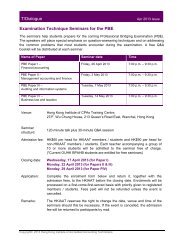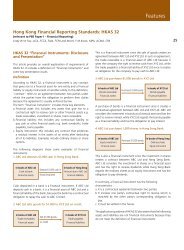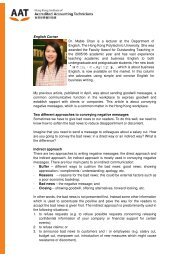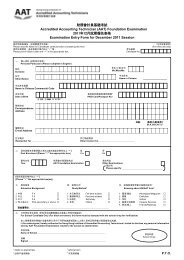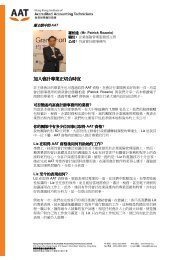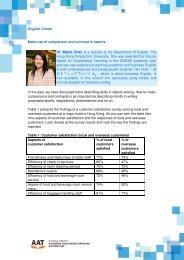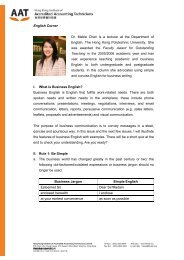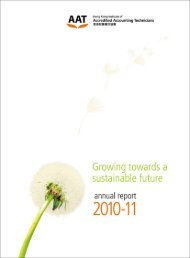The Cost Model and the Revaluation Model under HKAS 16 ...
The Cost Model and the Revaluation Model under HKAS 16 ...
The Cost Model and the Revaluation Model under HKAS 16 ...
You also want an ePaper? Increase the reach of your titles
YUMPU automatically turns print PDFs into web optimized ePapers that Google loves.
professional judgment <strong>and</strong> entity policy. In addition, <strong>the</strong> entity needs to perform an<br />
impairment test <strong>and</strong> compute impairment losses (if any) on <strong>the</strong> asset pursuant to <strong>HKAS</strong><br />
36 “Impairment of Assets”. <strong>The</strong> discussion of <strong>HKAS</strong> 36 is outside <strong>the</strong> scope of this article<br />
<strong>and</strong> <strong>the</strong> syllabus of Paper 7: Financial Accounting.<br />
<strong>Revaluation</strong> model<br />
When an entity adopts <strong>the</strong> revaluation model, <strong>the</strong> property, plant <strong>and</strong> equipment shall be<br />
carried at a revalued amount less subsequent accumulated depreciation <strong>and</strong><br />
accumulated impairment losses:<br />
Carrying amount <strong>under</strong> <strong>the</strong> revaluation model = revalued amount – accumulated<br />
depreciation – accumulated impairment losses.<br />
<strong>The</strong> revalued amount refers to <strong>the</strong> fair value of an item of property, plant <strong>and</strong> equipment<br />
at <strong>the</strong> date of revaluation. In order for <strong>the</strong> revaluation model to be used, it should be<br />
possible to measure <strong>the</strong> fair value of an item of property, plant <strong>and</strong> equipment reliably.<br />
Reliable measurement may be obtained through external evidence such as marketbased<br />
evidence or internal estimates using an income or a depreciated replacement cost<br />
approach.<br />
<strong>The</strong> entity shall make <strong>the</strong> revaluations with sufficient regularity to avoid material<br />
differences between <strong>the</strong> carrying amount <strong>and</strong> that which would be determined using fair<br />
value at <strong>the</strong> end of <strong>the</strong> reporting period.<br />
<strong>The</strong> revaluation model stipulated in <strong>HKAS</strong> <strong>16</strong> is different from <strong>the</strong> fair value model<br />
stipulated in <strong>HKAS</strong> 40 “Investment Property”.<br />
<strong>Revaluation</strong> surplus <strong>under</strong> revaluation model<br />
<strong>HKAS</strong> <strong>16</strong> also introduces <strong>the</strong> term “revaluation surplus” <strong>and</strong> describes its usage. (<strong>The</strong><br />
revaluation surplus is also known as <strong>the</strong> revaluation reserve.) <strong>The</strong> following discusses<br />
<strong>the</strong> circumstances when entries are put through <strong>the</strong> revaluation surplus account.<br />
1. When an asset’s carrying amount increases:<br />
<strong>The</strong> revaluation surplus is credited when an asset’s carrying amount increases<br />
due to revaluation. This increase is recognized in “O<strong>the</strong>r comprehensive income”<br />
<strong>and</strong> accumulated in equity <strong>under</strong> <strong>the</strong> “revaluation surplus” heading unless a<br />
previous revaluation decrease of <strong>the</strong> same asset has been recognized in <strong>the</strong><br />
profit or loss. When <strong>the</strong> carrying amount of <strong>the</strong> asset has fallen in previous years<br />
<strong>and</strong> <strong>the</strong> decrease has been recognized in profit or loss, <strong>the</strong> increase in <strong>the</strong><br />
current year shall <strong>the</strong>n be recognized in profit or loss to <strong>the</strong> same extent.<br />
2. When an asset’s carrying amount falls:<br />
When an asset’s carrying amount falls subsequent to a revaluation, <strong>the</strong> decrease<br />
is recognized as a loss unless <strong>the</strong>re is a credit balance in <strong>the</strong> revaluation surplus.<br />
When <strong>the</strong>re is a credit balance in <strong>the</strong> revaluation surplus of <strong>the</strong> same asset, <strong>the</strong><br />
- 2 -




